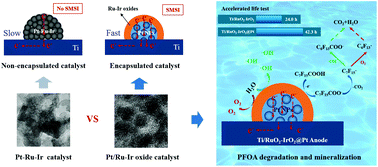Ultralong-lifetime Ti/RuO2–IrO2@Pt anodes with a strong metal–support interaction for efficient electrochemical mineralization of perfluorooctanoic acid†
Abstract
Electrocatalytic oxidation is regarded as an effective technique for decomposing refractory organic compounds like perfluorooctanoic acid (PFOA). However, achieving highly efficient and long-life electrodes is still a great challenge. Herein, Ti/RuO2–IrO2@Pt anodes consisting of Pt4+ and Pt0 species were fabricated by combining modified microemulsion technology with a calcination process, in which Pt nanoparticles were highly dispersed and encapsulated in Ru–Ir composite oxides to form a strong metal–support interaction (SMSI) structure. The as-constructed SMSI layer on the Ti/RuO2–IrO2@Pt anode resulted in the improvement of the charge transfer capability and also increased the degradation (99.30%) and mineralization (91.32%) of PFOA during the electrochemical oxidation process. Notably, the service lifetime of Ti/RuO2–IrO2@Pt anodes was remarkably improved from 24 to 42.3 h compared to commercial Ti/RuO2–IrO2 anodes. Moreover, the possible degradation mechanism of PFOA was also speculated through the detection of short-chain perfluorocarboxylic acids and reactive radicals. These results not only revealed that the concept and methodology of SMSI could be an effective way for constructing highly efficient and stable electrocatalysts but also greatly advanced fundamental understanding.



 Please wait while we load your content...
Please wait while we load your content...